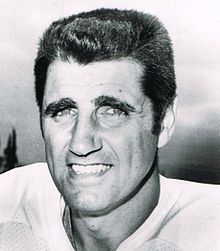
I heard yesterday that Earl Morrall died.
It always gives me pause when one of my heroes dies. It makes me aware of my own advancing time and that at some point, distant or near, I too will be crossing that border between life and death and come face to face with “the ol’ Rainmaker”, such as he is.
Be that as it may, those of you too young to remember Morrall, or who perhaps have become fans of the NFL later in life, will not have an appreciation for this man and the unique role he played during a pivotal time in NFL history. From memory only I will share with you the impact Earl Morrall had on my life. No internet research or biographies have been consulted in telling you what I say here—the memories are too vivid for that.
In 1968 I was a huge Baltimore Colts fan and had been so since the late ’50s when Johnny Unitas and company thrilled the nation with their sudden death, overtime NFL Championship game victory over the New York Giants.[1] By ’68 Unitas was approaching the end of his storied career but was still regarded as “the master”, and the Colts had re-tooled with a bevy of good, young players around him. I was looking forward to the season as one in which the Colts had a real shot at unseating those damn Green Bay Packers and, as the NFL champions, go to the Super Bowl against the AFL’s representative.[2]
And then disaster struck. In a pre-season game against the Dallas Cowboys Unitas felt a twinge in his elbow while making a short throw over the middle. At the time it seemed to be a minor injury and Colts fans thought their Hall of Fame bound quarterback would be OK for the start of the season. But it turned out Unitas wasn’t OK. Whatever was wrong with his elbow simply wasn’t recovering. It caused him pain when he tried to throw and he couldn’t get any zip on the ball.
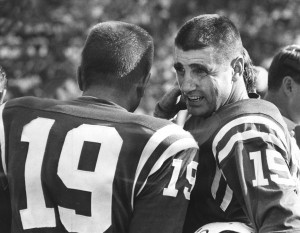
Like all Colts fans, as the start of the season approached and it became obvious that Unitas could not answer the bell, I became concerned. A back-up quarterback named Earl Morrall was tapped to step in and run the team, but without Unitas—geez—it seemed the season was over before it started. Thanks to Morrall it wasn’t.
One of the things about sports that we all love is when the unexpected underdog overcomes adversity and wins the day. Such is the story of Earl Morrall. Already in his mid 30’s, Morrall’s NFL career to that point had given no indication that he was capable of doing what he did with the Colts in that 1968 season. Earl may not have made us forget about Unitas that year, but he at least put him at the back of our minds. He was brilliant from the season’s first week, leading the Colts to an NFL best 13-1 season and winning the league’s Most Valuable Player award in the process. Once in the playoffs the Colts defeated the Minnesota Vikings and then shut out the Cleveland Browns 34-0 to win their third NFL title in their 16 season history. To that point that ’68 season could not have gone any better even IF Unitas had been quarterback.
Then came Super Bowl III against the AFL’s Joe Namath and the New York Jets. The Colts went into the game, which was played in the Orange Bowl in Miami, as prohibitive 19 point favorites. Every pundit on the planet thought the Jets had no chance, me included. That famous picture of New York quarterback Joe Namath sunning himself by a pool in Miami that was taken as he was making his casual prediction that his Jets would defeat the Colts—“I guarantee it,” he said—notwithstanding, I was looking forward to Baltimore putting the capper on a World Championship season by crushing the Jets in the Super Bowl.
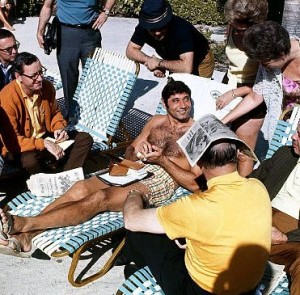
Instead, in Super Bowl III Earl Morrall had his one bad game of the season and the Colts lost to Namath and the Jets in historic fashion 16-7. I watched the game in stunned disbelief. Nothing went right for the Colts. The play that really stands out in my mind took place, I believe, late in the first half. The Colts had played poorly to that point but I knew they would turn it around and come back for the victory. The play, what the Colts called a “fleaflicker”, was a simple handoff to a running back on a sweep to the right, who would then stop and make a backward pass to Morrall, who would then throw a deep pass to a receiver. The Colts had run the play during the season to perfection and on that occasion Morrall had hit wide receiver Jimmy Orr for a touchdown. Against the Jets, when Morrall got the pass back from the running back and looked down field he apparently did not see the wide open Jimmy Orr who was running 10 yards behind any Jets defender. Instead he tried to hit an underneath receiver and the ball was picked off by the Jets’ Jim Hudson. When that happened I knew the Colts were in trouble. Head coach Don Shula finally put Unitas, who had mostly recovered from his elbow injury, in the game in the 4th quarter and he led Baltimore to one touchdown, but it was too little too late to change the outcome.
The impact of Baltimore’s loss to the Jets in Super Bowl III was that it demonstrated that a much greater level of parity existed between the two leagues than most people realized. By the time of Super Bowl III the AFL and NFL had already agreed to a merger that would take place a season or two later, but the Jets stunning victory over the Colts confirmed it as the correct thing to do.
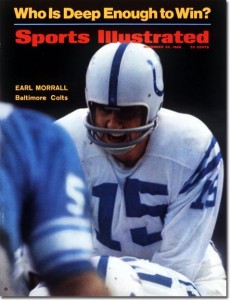
Since he was already 34 years old at the time, you might think that this would be a bad way for Morrall to wind up his career, but the guy was a late bloomer and was just getting started. Two years later in Super Bowl V he was still with the Colts and still backing up Unitas, only this time the Colts were playing the Dallas Cowboys in the Big Game. Unitas was injured early in the game and once again, in came Earl Morrall. He may not have played great that day, but neither did he make the devastating mistake; and consequently the Colts pulled it out on a last second field goal by Jim O’Brien to win their first ever Super Bowl.
With that Super Bowl victory perhaps it would have been a good time to retire, but for Earl Morrall the best was yet to come. In the spring of 1972 the Miami Dolphins acquired him for a $100 waiver fee and he re-joined his old coach Don Shula who had left Baltimore for Miami a couple of years earlier. The ’72 season started fast for the Dolphins and after week 4 they were leading their division with a 4-0 record. In week 5 Dolphins starting quarterback Bob Griese was injured and, like us Colts fans in ’68, Dolphins fans feared the worst for their team.
They needn’t have worried. Into the Dolphins quarterback void stepped Earl Morral, who proceeded to lead the team to an undefeated regular season as well as a first round playoff game victory over the Cleveland Browns. Against the Pittsburgh Steelers in the ’72 AFC Championship game Morrall struggled, but by taking over for 11 games he had bought enough time for Griese to recover. In that Pittsburgh game Shula replaced Morral with Griese and the Dolphins went on to defeat the Steelers and then completed the NFL’s only undefeated season ever by beating the Washington Redskins in the Super Bowl 14-7. It never would have happened without Earl Morrall.
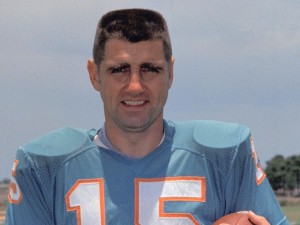
For me, Earl Morrall demonstrated in his career and in his life the power of persistence and the importance of never getting down on yourself. He was a career second stringer who was a first stringer in his heart; and who, I think, never agreed otherwise. I never met him or talked to him, but I think if I had he would have told me that.
And so, we bid you farewell Earl Morrall. Thank you for your impact on our lives, which, except for missing Jimmy Orr on that fleaflicker in that Super Bowl III loss to the Jets, was nothing but inspirational.
Your record speaks for itself and you are, for my money, the greatest back-up quarterback who ever lived.
Copyright © 2014
By Mark Arnold
All Rights Reserved
[1] The 1958 overtime, sudden death NFL championship game between the Baltimore Colts and the New York Giants, won by the Colts 23-17, is widely considered the greatest game ever played, not just for the thrilling play on the field but for the impact it had on the use of the relatively new medium of television for the broadcasting of games. With that game the NFL arrived in the “television age”.
[2] In 1968 the NFL and the AFL had yet to merge and were to separate leagues. The merging of the two was agreed to in 1967 but did not take place until 1970


2 Responses
Great read Mark! And now that I have the the whole story I would agree with you that he was the greatest back up quarterback of all time!
Thanks Steve! When I heard Morrall had died I just had to get it all off my chest. I lived and died with that guy back in ’68-70…as did Dolphins fans in ’72. He had a remarkable career at a pivotal point in NFL history, the time when the NFL and AFL merged. A lot of memories….L Mark